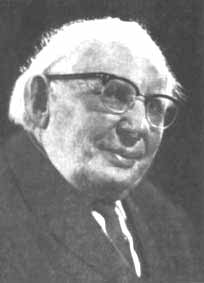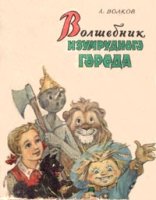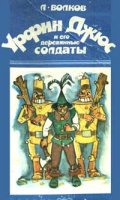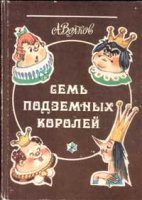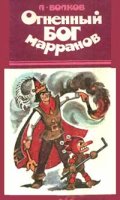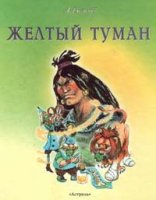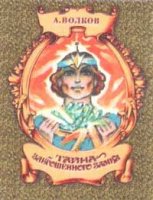About the Oz Books: Difference between revisions
Ericgjovaag (talk | contribs) |
Ericgjovaag (talk | contribs) |
||
| Line 52: | Line 52: | ||
[[File:READOZ.JPG|left|frame|alt=Glinda reading Oz books|Illustration by John R. Neill from Kabumpo in Oz, © 1922 The Reilly and Lee Co.]]It all depends. While it's nice to read them in the order they were published, it's not critical, as each story is self-contained. Any information you might need to know from a previous book is usually summarized in the book you're reading. My recommendation is to try to read the first seven or so books in order, to help set up the entire series and its characters, then read the rest of the books in whatever order you choose. (Some titles are harder to find than others, so you may not even be able to find them all in order.) There are some cases, however, where it helps to read one book before another. I recommend reading ''The Royal Book of Oz'' before ''The Yellow Knight of Oz'', ''Kabumpo in Oz'' before ''The Purple Prince of Oz'', ''Pirates in Oz'' before ''Captain Salt in Oz'', ''The Purple Prince of Oz'' before ''The Silver Princess in Oz'', and ''The Wonder City of Oz'' before ''The Scalawagons of Oz''. I'd also recommend reading Baum's non-Oz books ''The Sea Fairies'' and ''Sky Island'' between ''The Road to Oz'' and ''The Scarecrow of Oz''. | [[File:READOZ.JPG|left|frame|alt=Glinda reading Oz books|Illustration by John R. Neill from Kabumpo in Oz, © 1922 The Reilly and Lee Co.]]It all depends. While it's nice to read them in the order they were published, it's not critical, as each story is self-contained. Any information you might need to know from a previous book is usually summarized in the book you're reading. My recommendation is to try to read the first seven or so books in order, to help set up the entire series and its characters, then read the rest of the books in whatever order you choose. (Some titles are harder to find than others, so you may not even be able to find them all in order.) There are some cases, however, where it helps to read one book before another. I recommend reading ''The Royal Book of Oz'' before ''The Yellow Knight of Oz'', ''Kabumpo in Oz'' before ''The Purple Prince of Oz'', ''Pirates in Oz'' before ''Captain Salt in Oz'', ''The Purple Prince of Oz'' before ''The Silver Princess in Oz'', and ''The Wonder City of Oz'' before ''The Scalawagons of Oz''. I'd also recommend reading Baum's non-Oz books ''The Sea Fairies'' and ''Sky Island'' between ''The Road to Oz'' and ''The Scarecrow of Oz''. | ||
If you have read all of the books by Baum and want to see how his successor holds up, you may want to ''not'' read ''The Royal Book of Oz'' next. It is, frankly, a bit of a mess. More importantly, however, is that it's not typical of most of the rest of Ruth Plumly Thompson's Oz books. Many Baum fans have given up on the series after reading ''The Royal Book of Oz''. If you want a better idea of Thompson's Oz, I recommend her next book, and the first under which she was fully credited as Royal Historian, ''Kabumpo in Oz''. If you enjoy that book, then you will probably enjoy the rest of her books, and you can then go back and try ''The Royal Book of Oz'' later. If, on the other hand, ''Kabumpo'' isn't your cup of tea, then you will probably be happier just sticking to Baum's books. | If you have read all of the books by Baum and want to see how his successor holds up, you may want to ''not'' read ''The Royal Book of Oz'' next. It is, frankly, a bit of a mess. More importantly, however, is that it's not typical of most of the rest of Ruth Plumly Thompson's Oz books. Many Baum fans have given up on the series after reading ''The Royal Book of Oz''. If you want a better idea of Thompson's Oz, I recommend her next book, and the first under which she was fully credited as Royal Historian, ''Kabumpo in Oz''. If you enjoy that book, then you will probably enjoy the rest of her books, and you can then go back and try ''The Royal Book of Oz'' later. If, on the other hand, ''Kabumpo'' isn't your cup of tea, then you will probably be happier just sticking to Baum's books, or skipping Thompson and Neill and going straight to Jack Snow, who was a strict Baumist and did not use any characters or events created by other writers. | ||
{{clear}} | {{clear}} | ||
Revision as of 17:35, 19 June 2019
What are the "official" Oz books?
Here is the complete list of the Famous Forty Oz books (often shortened to the FF) — the ones that most Oz fans agree are true Oz — along with their authors, dates of publication, and the front cover of the first edition. They were also listed on dust jackets and advertisements from the then-official publishers, Reilly and Lee.
- The Wizard of Oz, originally published as The Wonderful Wizard of Oz (L. Frank Baum, 1900); also published as The New Wizard of Oz (1903)
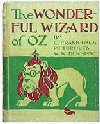
- The Land of Oz, originally published as The Marvelous Land of Oz (L. Frank Baum, 1904)

- Ozma of Oz (L. Frank Baum, 1907)
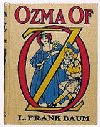
- Dorothy and the Wizard in Oz, with Little Dorothy and the Wizard in Oz used in the running titles at the top of the pages (L. Frank Baum, 1908)
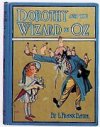
- The Road to Oz (L. Frank Baum, 1909)
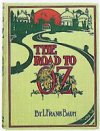
- The Emerald City of Oz (L. Frank Baum, 1910)
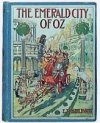
- The Patchwork Girl of Oz (L. Frank Baum, 1913)
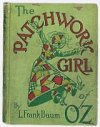
- Tik-Tok of Oz (L. Frank Baum, 1914)
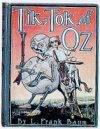
- The Scarecrow of Oz (L. Frank Baum, 1915)
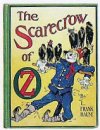
- Rinkitink in Oz (L. Frank Baum, 1916)
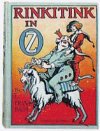
- The Lost Princess of Oz (L. Frank Baum, 1917)
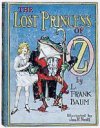
- The Tin Woodman of Oz (L. Frank Baum, 1918)
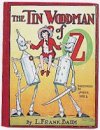
- The Magic of Oz (L. Frank Baum, 1919)
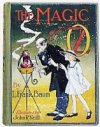
- Glinda of Oz (L. Frank Baum, 1920)
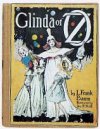
- The Royal Book of Oz (Ruth Plumly Thompson [but originally attributed to L. Frank Baum], 1921)
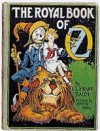
- Kabumpo in Oz (Ruth Plumly Thompson, 1922)

- The Cowardly Lion of Oz (Ruth Plumly Thompson, 1923)
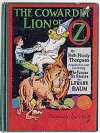
- Grampa in Oz (Ruth Plumly Thompson, 1924)
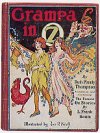
- The Lost King of Oz (Ruth Plumly Thompson, 1925)
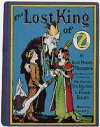
- The Hungry Tiger of Oz (Ruth Plumly Thompson, 1926)
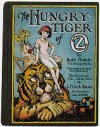
- The Gnome King of Oz (Ruth Plumly Thompson, 1927)
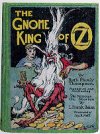
- The Giant Horse of Oz (Ruth Plumly Thompson, 1928)
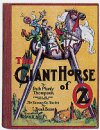
- Jack Pumpkinhead of Oz (Ruth Plumly Thompson, 1929)
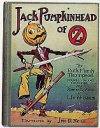
- The Yellow Knight of Oz (Ruth Plumly Thompson, 1930)
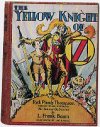
- Pirates in Oz (Ruth Plumly Thompson, 1931)
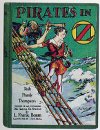
- The Purple Prince of Oz (Ruth Plumly Thompson, 1932)
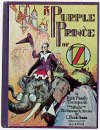
- Ojo in Oz (Ruth Plumly Thompson, 1933)
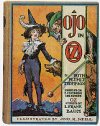
- Speedy in Oz (Ruth Plumly Thompson, 1934)
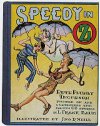
- The Wishing Horse of Oz (Ruth Plumly Thompson, 1935)
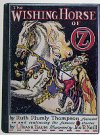
- Captain Salt in Oz (Ruth Plumly Thompson, 1936)
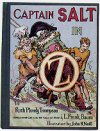
- Handy Mandy in Oz (Ruth Plumly Thompson, 1937)
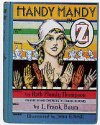
- The Silver Princess in Oz (Ruth Plumly Thompson, 1938)
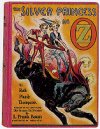
- Ozoplaning with the Wizard of Oz (Ruth Plumly Thompson, 1939)
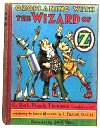
- The Wonder City of Oz (John R. Neill, 1940)
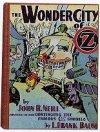
- The Scalawagons of Oz (John R. Neill, 1941)
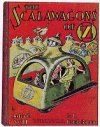
- Lucky Bucky in Oz (John R. Neill, 1942)
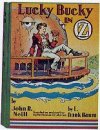
- The Magical Mimics in Oz (Jack Snow, 1946)
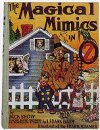
- The Shaggy Man of Oz (Jack Snow, 1949)
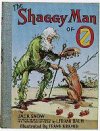
- The Hidden Valley of Oz (Rachel R. Cosgrove, 1951)

- Merry Go Round in Oz (Eloise Jarvis McGraw and Lauren McGraw Wagner, 1963)
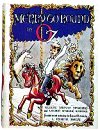
If the later books are written by other authors, why is L. Frank Baum's name on the cover?
Beginning with Kabumpo in Oz, the phrase "Founded on and Continuing the Famous Oz Stories by L. Frank Baum" was included as part of every book published by Reilly and Lee. This was part of the contract between Reilly and Lee and Maud Baum to allow the series to continue. Not only did the phrase have to be on new Oz books, L. Frank Baum's name had to be in the same size and typeface as the book's author. This does not mean in any way that the stories are based on anything Baum wrote. The stories are all the complete and original creations of the men and women who wrote them.
In what order should I read these books?
It all depends. While it's nice to read them in the order they were published, it's not critical, as each story is self-contained. Any information you might need to know from a previous book is usually summarized in the book you're reading. My recommendation is to try to read the first seven or so books in order, to help set up the entire series and its characters, then read the rest of the books in whatever order you choose. (Some titles are harder to find than others, so you may not even be able to find them all in order.) There are some cases, however, where it helps to read one book before another. I recommend reading The Royal Book of Oz before The Yellow Knight of Oz, Kabumpo in Oz before The Purple Prince of Oz, Pirates in Oz before Captain Salt in Oz, The Purple Prince of Oz before The Silver Princess in Oz, and The Wonder City of Oz before The Scalawagons of Oz. I'd also recommend reading Baum's non-Oz books The Sea Fairies and Sky Island between The Road to Oz and The Scarecrow of Oz.
If you have read all of the books by Baum and want to see how his successor holds up, you may want to not read The Royal Book of Oz next. It is, frankly, a bit of a mess. More importantly, however, is that it's not typical of most of the rest of Ruth Plumly Thompson's Oz books. Many Baum fans have given up on the series after reading The Royal Book of Oz. If you want a better idea of Thompson's Oz, I recommend her next book, and the first under which she was fully credited as Royal Historian, Kabumpo in Oz. If you enjoy that book, then you will probably enjoy the rest of her books, and you can then go back and try The Royal Book of Oz later. If, on the other hand, Kabumpo isn't your cup of tea, then you will probably be happier just sticking to Baum's books, or skipping Thompson and Neill and going straight to Jack Snow, who was a strict Baumist and did not use any characters or events created by other writers.
If these are the "official" Oz books, does that mean that there are others?
Yes. All of the authors and many of the illustrators of the Oz books listed above have written other Oz stories, but because they weren't as well known or well distributed, or not kept in print as long as the other books, or are a bit of a departure from the rest of the books, or published by a company other than Reilly and Lee, they are not generally considered part of the "official" series. (These additional books by "official" Oz authors and illustrators are discussed in the sections on L. Frank Baum, the Royal Historian of Oz and The Other Royal Historians and Illustrators of Oz). Also, since 1956, when the copyright on The Wizard of Oz expired in the United States and the characters entered the public domain, a number of other authors have written and published Oz books outside of the regular series. There are now even publishers devoted to putting out nothing but original Oz stories. For an older list of some of these books (many of which have yet to be published), go to https://web.archive.org/web/20100722080111/http://members.cox.net/cruentidei/oz/hacc/hacc.html and http://www.oztimeline.net/Mainlinetimeline.htm on the WWW. An even more comprehensive list of Oz and Oz-related books is available at http://theozindex.com/, and an old list of Oz pastiches can be found at http://web.archive.org/web/20070723130630/www.ozclub.org/reference/pastiche.asp.
Please note that there is no general consensus as to what an Oz book actually is, or which ones should or shouldn't count in some situations. (This is why quote marks are put around "official" in this section.) While the FF is generally accepted, there are some who are fans only of the L. Frank Baum books, while others try to include every single Oz book published. There is no one central authority to say what is official, and so Oz fans can pick and choose which ones are "official" to them. Many read and enjoy other Oz books, even if they don't personally consider them all to be "official".
Who published these Oz books?
The Wonderful Wizard of Oz was first published by the George M. Hill Company. Bobbs-Merrill became the primary publisher after Hill went bankrupt, and was the main publisher until 1956. All of the rest of the FF were originally published by the Reilly and Britton Company, which changed its name to Reilly and Lee in 1919. Under its new name, Reilly and Lee continued to publish new Oz books and reprint older titles in the series. Reilly and Lee finally published its own edition of The Wizard of Oz in 1956, when it entered the public domain. In the late 1950s, Reilly and Lee was bought by the Henry Regnery Company, and the Reilly and Lee imprint was used solely on the Oz and other children's books. It's a little unclear what happened next, but either Regnery changed its name to Contemporary Books (then another Regnery publishing company started up, which is still in business), or Contemporary Books procured the rights to the Oz books. At any rate, Contemporary, which is now a division of McGraw-Hill, had the rights for a while, but they are no longer publishing Oz books. Today, Oz books, particularly those titles in public domain, are coming out from many different publishers.
Who illustrated the books?
The Wonderful Wizard of Oz was originally illustrated by W. W. (William Wallace) Denslow, a friend of Baum's. In 1904 Baum's new publishers hired John R. Neill to illustrate The Marvelous Land of Oz, and he illustrated all subsequent Oz books until his death in 1943. The two books by Jack Snow were illustrated by Frank Kramer, The Hidden Valley of Oz by Dirk (his full name was Dirk Gringhuis), and Merry Go Round in Oz by Dick Martin. Numerous other artists have illustrated The Wizard of Oz over the years, most notably Evelyn Copelman, Dale Ulrey, Maraja, Michael Hague, Charles Santore, Lisbeth Zwerger, Greg Hildebrandt, Barry Moser, Robert Ingpen and Michael McCurdy. Many foreign editions have also had new illustrations.
What's the first line of The Wizard of Oz?
This is one of the oddest questions I've ever gotten — because it's so obscure, yet I've been asked it many times! I finally asked one person why he needed to know, and he confirmed my suspicions: It's an item on an Internet scavenger hunt, given out by computer teachers. Normally, I'd advise people to check out the online editions of the Oz books (see the links page to online Oz books at http://thewizardofoz.info/wiki/Online_Oz_books) — but as this is a list of frequently asked questions, I've relented:
- Dorothy lived in the midst of the great Kansas prairies, with Uncle Henry, who was a farmer, and Aunt Em, who was the farmer's wife.
(A note to teachers who may be assigning this scavenger hunt in the future: It might be a good idea to emphasize that the students are to find the items on their own, not e-mail people or post a message and ask for the answers outright. You may want to require a URL where they found the answer besides the answer itself. I speak from experience, not only from receiving all those e-mails, but also being a teacher myself.)
What's the difference between the books The Wonderful Wizard of Oz, The Wizard of Oz, and The New Wizard of Oz?
Very little. The book was first published by George M. Hill as The Wonderful Wizard of Oz, but soon afterwards, despite the success of their new book, the publisher went bankrupt. By the time the book was reissued, the story had become a hit play under the shortened name The Wizard of Oz. The new publisher, Bobbs-Merrill, used the original Hill printing plates, but called the book The New Wizard of Oz. The New was quickly dropped from the cover, however, and the book became better known simply as The Wizard of Oz. It was officially still titled The New Wizard of Oz, since that was the title on record at the copyright office, and on the title page until 1956. For some reason, this edition replaced yellow daisies and yellow flowers in chapter 14 with bright daisies and scarlet flowers, but that is the only change in the text. The earliest editions also gave chapter 13 two different titles, "How the Four Were Reunited" in the table of contents page, and "The Rescue" in the running chapter heads of the text itself. Later editions cleared this up by resetting the table of contents to read "The Rescue" for chapter 13. When the copyright on the story expired in 1956, numerous publishers put out their own editions under all three titles (and with both styles of flowers and names for chapter 13), a practice still going on today. But other than the title, they are all the same story. The New is rarely used today, however. While most people know the story as The Wizard of Oz, some people do prefer to use the full original title, The Wonderful Wizard of Oz, some so as to differentiate it from The Movie.
What's the difference between The Marvelous Land of Oz and The Land of Oz?
As with the first book, none, save for a word in the title. Soon after publication, Reilly and Britton, as the publishers were then called, shortened the title on the cover, although the Marvelous remained on the title page for several more years. Now, like the first book, this title is published under both names.
Early editions of The Royal Book of Oz say that it was written by Baum, but later ones say it was written by Ruth Plumly Thompson. What's up with that?
The cover of all Reilly and Lee editions of The Royal Book of Oz listed Baum as the author, and the title page added, "Enlarged and Edited by Ruth Plumly Thompson." This was a ruse on the publisher's part, as the entire work was Thompson's. Baum's widow, Maud Baum, added to the smokescreen by writing a preface for the new book that mentioned some notes her husband had left that formed the basis for the story. It was felt that this would ease the transition from one writer to the next. Thompson's sole authorship of The Royal Book of Oz was first acknowledged in Jack Snow's Who's Who in Oz, published in 1954, and the first edition to feature Thompson's name on the cover as author was the Del Rey paperback edition of 1985. The Dover edition of 2001 retained Baum's name for the sake of authenticity.
For what age are the Oz books written?
This is a question L. Frank Baum himself was asked, and answered in his introduction to The Tin Woodman of Oz:
- A learned college professor recently wrote me to ask: "For readers of what age are your books intended?" It puzzled me to answer that properly, until I had looked over some of the letters I have received. One says: "I'm a little boy of 5 years old, and I just love your Oz stories. My sister, who is writing this for me, reads me the Oz books, but I wish I could read them myself." Another letter says: "I'm a great girl 13 years old, so you'll be surprised when I tell you I am not too old yet for the Oz stories." Here's another letter: "Since I was a young girl I've never missed getting a Baum book for Christmas. I'm married, now, but am as eager to get and read the Oz stories as ever." And still another writes: "My good wife and I, both more than 70 years of age, believe that we find more real enjoyment in your Oz books than in any other books we read." Considering these statements, I wrote the college professor that my books are intended for all those whose hearts are young, no matter what their ages may be.
This answer works very nicely. Some recent Oz books, however, are written for an older audience, and include some adult themes, language, and actions. Cautious parents and sensitive readers may want to research which books meet their own tastes and requirements.
Did The Wizard of Oz or any of the other Oz books ever receive any book awards?
The Wonderful Wizard of Oz was published in 1900. The Newbery Medal, the earliest prize for American children's books, was first awarded in 1922. So no, The Wizard of Oz didn't win any awards in its day, but there were no children's book awards at the time to be won. None of the later books received awards, either, but The Wizard of Oz and the Oz series in general have appeared on several lists of best/favorite/most beloved/etc. books over the last few decades. One such list is Books That Shaped America, issued by the Library of Congress in 2012, which included The Wonderful Wizard of Oz. Also, The Wonderful Wizard of Oz was given a Lewis Carroll Shelf Award in 1968 as a book deemed to "belong on the same shelf" as Carroll's Alice books.
Are the Oz books still under copyright?
Some of them are and some aren't. As of this writing, the following Oz books have entered public domain in the United States:
- All of the titles written by Baum
- The Royal Book of Oz
- Kabumpo in Oz
- The Cowardly Lion of Oz
- The Wishing Horse of Oz
- Captain Salt in Oz
- Handy Mandy in Oz
- The Silver Princess in Oz
- Ozoplaning with the Wizard of Oz
- The Magical Mimics in Oz
- The Shaggy Man of Oz
The original illustrations in those books are also public domain. All other Oz books are still under copyright, but have started entering it again as of 2019. (In case you were wondering, the later Thompson books and those by Snow are public domain because, at the time, copyrights were good for twenty-eight years, then a further twenty-eight if the copyright was renewed — and the copyrights were not renewed on those books.) Outside of these public domain books, the copyrights on both the story and the illustrations are held by the individual writers of the books, or their estates. The rights on the Thompson books still under copyright are now administered by the Baum Trust. Information about current United States copyright law and what is and isn't public domain can be found at http://www.copyright.cornell.edu/training/Hirtle_Public_Domain.htm. Those wondering about copyright laws in other countries and how they affect Oz books should consult a local copyright lawyer or government copyright office. Several WWW sites dealing with American and British copyright can be found at http://thewizardofoz.info/wiki/For_Oz_writers. And Wikipedia has a thorough article about the copyright status of the books and many of the movies at https://en.wikipedia.org/wiki/Copyright_status_of_The_Wizard_of_Oz_and_related_works_in_the_United_States.
Were the Oz books ever published in countries outside of the United States?
Most certainly. Over the decades there have been numerous Canadian and British editions of the Baum Oz books, and The Wizard of Oz is first known to have been translated into another language, French, in 1932. The Wizard of Oz, other Oz books, and a few of Baum's non-Oz books have now been translated into a number of different languages, and published in many editions. Even some of the books by other Oz authors are starting to show up in translations around the world. Many of the earliest books published abroad were not translations, but retellings of the story from The Movie.
What's this I hear about a different Oz series in Russia?
It's true. There is a series, first published in the Soviet Union, that started off in a familiar fashion, but then went in a different direction. In 1939, a new book by Aleksandr Volkov was published in Moscow, Волшебник Изумрудного Города, or Volshebnik Izumrudnogo Goroda — The Wizard of the City of Emeralds. While purporting to be an original tale, the story of Elli and her dog Totoshka, Strasheela the Scarecrow, the Iron Woodchopper, and the Cowardly Lion was easily recognizable as The Wizard of Oz. The country was not named Oz, however, and was generally referred to as Magic Land. The first edition was illustrated by N. Radlov. In 1959, a revised edition, illustrated by L. Vladimirski, appeared. Both editions acknowledge Baum and The Wizard of Oz as inspiring the story, but the 1959 edition gave Baum more credit and emphasis. This edition was followed by an original sequel, Урфин Джюс и его Деревянные Солдаты, or Urfin Dzhus i yevo Dyerevyannie Soldati (Urfin Dzhus and His Wooden Soldiers) in 1963. Later additions to the series were Семь Подземных Королей, or Syem Pozyemnich Koroly (Seven Underground Kings, 1969), Огненный Бог Марранов, or Ognyennei Bog Marranov (The Fire God of the Maronnes, 1972), желтый Туман, or Zholti Tuman (The Yellow Fog, 1974), and Тайна Заброшенного Замка, or Taina Zabrosynnovo Zamka (The Secret of the Deserted Castle, serialized in the 1970s and published posthumously as a book in 1982), all illustrated by Vladimirski (many of his pictures can be found at http://volkov.anuta.org/). The series proved to be popular enough in Russian that many of the books have been translated into other languages — including English (currently available from Lulu.com). The exchange has now gone both ways, as some of the Oz books have recently been translated into Russian. Volkov died in 1977, but others have continued the series since then. Volshebnik Izumrudnogo Goroda has also been performed on the Russian stage, shown in theaters and on television, and released on video. The books were also translated into many other languages behind the Iron Curtain, and the series is especially remembered in the former East Germany.
Is it true that The Wizard of Oz was written as a political tract?
Nope. Baum was not very active in politics, and none of his other stories could be considered political works.
The connection between The Wizard of Oz and the contemporary political landscape was not even raised until 1963, when a summer school teacher named Henry Littlefield, while trying to teach the 1896 Presidential election and the turn-of-the-century Populist movement to bored history students, stumbled upon the idea of using the characters and events of The Wizard of Oz as metaphors to teach the concepts. He and his students made a number of connections — the Scarecrow represented the farmers, the Tin Woodman the factory workers, the Wizard was President Grover Cleveland or Republican presidential candidate William McKinley, the Cowardly Lion was Democratic presidential candidate William Jennings Bryan, the silver shoes were the silver standard, the yellow brick road the gold standard, and so on — and Littlefield eventually wrote an article, "The Wizard of Oz: A Parable on Populism," which was published in the magazine American Quarterly in 1964. You can read this article on the WWW at https://web.archive.org/web/20150318074257/http://www.amphigory.com/oz.htm.
Littlefield's article seems not to have been taken to heart and was generally forgotten, until Gore Vidal, writing about Oz in The New York Review of Books in 1977, mentioned the article, and the idea took off. Unfortunately, a number of other articles later came out that misunderstood or reinterpreted what Littlefield had said or meant, and other writers took the ideas even further, many not even aware of Littlefield's original essay. Some of these interpretations even contradict each other, and others invented political leanings for Baum he did not hold (his early newspaper columns show a stronger leaning towards the Republicans than the Populists — and this was the nineteenth century Republican party, which was generally perceived as being more progressive in its day than the more status quo-oriented Democrats). Some of these interpretations have been embraced by college professors and other academics as the true meaning behind The Wizard of Oz. Littlefield took pains to say, then and later, that he does not believe Baum had a political agenda in writing The Wizard of Oz, and that his observations were allegorical and not meant to be the final word. The Baum family and many Oz and Baum scholars have also proclaimed that it was not Baum's intention to write a deliberate satire. Still, this has not stopped many people from taking a quaint set of metaphors and converting them into "fact."
Like almost any great literary work, one can interpret The Wizard of Oz in any number of ways, if one tries hard enough. Other interpretations of the book that have been published include spiritual (Baum did have an interest in Theosophy, but he was not an overtly religious man), mythic, psychological (Freudian, Jungian, and others), feminist, capitalist, and socialist/Communist, as well as commentaries on contemporary China and Japan. However, Baum merely wanted to tell a good story, and not to add any hidden meaning. He wrote in his introduction to The Wonderful Wizard of Oz: "Modern education includes morality; therefore the modern child seeks only entertainment [emphasis mine] in its wonder-tales and gladly dispenses with all disagreeable incident. Having this thought in mind, the story of The Wonderful Wizard of Oz was written solely to please the children of today [emphasis mine]."
Here's another issue to consider: If The Wonderful Wizard of Oz was written as a political work, then it makes sense that Baum would have included politics in some of his other stories. Yet nobody has made this sort of connection with any of his other books. True, Baum does make some sly comments about contemporary events in some of his books (the spoof of the Women's Suffrage movement in The Land of Oz being the most striking example), but nothing to the extent that some have made out to be in The Wizard of Oz. "Oh," I can hear some commentators saying, "but The Wizard of Oz is Baum's greatest and best-known work. Surely he put more into it than anything else he wrote." But Baum didn't know that it would be his greatest achievement when he wrote it, nor when it was first published. It was just another story he wrote, and he spent the rest of his life trying to do even better.
What's with all the drug references in Oz?
You're kidding, right? The Oz books are not riddled with drug references. I suspect many of the critics who claim this have not actually read the books. It's true, heroin and opium are made from poppies, which is why Dorothy, Toto, and the Cowardly Lion fall asleep in the poppy field, but this is hardly a secret. These drugs and their origins were well known at the turn of the century when Baum wrote the book. Drug use was also less stigmatized at the time as well, although it certainly wasn't met with universal approval, either. Baum himself was not a drug user; his strongest vice was the occasional cigar. In the book, the travelers are rescued from the poppies by the Scarecrow and the Tin Woodman, who carry Dorothy and Toto out, and a band of field mice which hauls out the Cowardly Lion. The snowstorm (snow is a slang term for cocaine, hence others seeing this as another drug reference) that kills the poppies originates in the 1902 stage play, and was reused for The Movie.
Why are there so many inconsistencies in the Oz books?
Like any other long series of books (or movies or television shows, for that matter), a few inconsistencies have shown up within the books. The questions Why do some books have the Munchkin Country in the west and the Winkie Country in the east? and What's the name of the Soldier with the Green Whiskers? are two examples, and there are several other smaller flubs and the like that have appeared in the books as well. Some Oz fans have had some fun creating fanciful explanations for these contradictions, but for the most part readers don't worry about them too much. This can all be traced to the fact that The Wonderful Wizard of Oz was not originally written with a series in mind, but as a stand-alone novel. The sequel, The Marvelous Land of Oz, also wasn't written with a series in mind. By the time Baum wrote the third book, Ozma of Oz, however, he had agreed to write several more Oz books, and so had to start figuring out the rules for his creation. Baum was blazing a new trail, as he was one of the first authors to create a series of fantasy novels. Furthermore, the next two and a half books — Ozma of Oz, Dorothy and the Wizard in Oz, and the first half of The Road to Oz — take place primarily outside of Oz, so Baum had little chance to develop his new land. And by the time he got back to Oz for a full book, in The Emerald City of Oz, Baum had intended to end the Oz series. So over the first six books, there isn't a lot of consistency because there was no call for it, and nobody thought it would be needed. Plus, he was developing the rules as he went — which is why there is money in The Marvelous Land of Oz, but its use had been abolished by The Road to Oz, to give one example. When Baum returned to writing Oz full time, he had a better idea what was going on and what his country was like, and so had an easier time of it — although he still contradicted himself at times. Then when other authors took over from Baum, they brought some of their own ideas and thoughts about Oz to the books, causing other minor inconsistencies. The vast majority of readers didn't notice or care, however. So don't let a small inconsistency get in the way of enjoying a good Oz story. However, if you really need an explanation for all of the inconsistencies, and how all of the Oz books can fit together, I'd recommend that you read the novel Paradox in Oz by Edward Einhorn. In that book, Ozma visits a number of different versions of Oz, and their existence is explained in an unusual and Ozzy way.
Are Oz books available at my local library?
It used to be, not so long ago, that some libraries, as a rule, didn't carry the Oz books. Some librarians just didn't stock long series of books, because of the expense and shelf space. Others unfairly linked Baum with poor writing, or didn't like some of the messages conveyed in the books. Some even thought that fantasy was bad for children to read. And it didn't help that Reilly and Lee was not a big publishing house, able to generate enough publicity and interest for libraries to want to carry them. (Most of the recommended reading lists that libraries used to select books were compiled by the big publishing houses, who ignored the Oz books because they didn't publish them.) But more recently, the Oz books have gained a steady audience, and many Oz fans have introduced the books to their children and grandchildren, so more librarians have grown up as Oz fans, and now stock the books. The popularity of The Movie has not hurt the situation. The Baum books, and many of his recently reprinted non-Oz titles, are now generally available in most public children's libraries, many elementary school libraries, and university libraries, the latter usually in the education department. For other books it may be more difficult, as fewer libraries carry them, but most libraries have an interlibrary loan program where they can borrow books from another library, then lend it to you. Some Oz fans have reported being able to read the entire FF, all of Baum's fantasies, and a large number of other books solely through interlibrary loan. Ask your librarian or consult your local library's website for more information.
Have the Oz books ever been banned, edited, or censored?
Sadly, yes. There have been a few attempts to remove The Wizard of Oz from school libraries or reading lists. None have been successful, so far as I've been able to discover, although some school students in Tennessee and Louisiana have been excused from reading the book on religious grounds. Some reasons critics have given, for example, is that the book depicts good witches, which they claim is theologically impossible, and that animals are elevated to the same level as humans. And as stated in the previous question, some public libraries used to not carry the Oz books for various reasons. While The Wizard of Oz couldn't be found on the shelves of the Chicago library system as early as 1928, two of the most notorious incidents took place in the 1950s, when Senator Joseph McCarthy and the House Un-American Activities Committee were active and saw Communism in all aspects of life. Many libraries removed a number of books, including the Oz books, for being too "radical." Fantasy was also felt to be harmful to children at the time, and many believed that children's books should be more educational. In Detroit in 1957, Director Ralph Ulveling admitted that The Wizard of Oz had not been available in the main library's children's room or any branch for thirty years, as it was not well-written, "the story relies on fantastic rather than fanciful happenings," the story didn't build to any sort of climax, "there is too much exaggeration in carrying out each detail, [and is] old-fashioned and out-dated...It does not meet present day standards of book selection for children." On a catalog card for the book in 1939, a Detroit library employee wrote, "[T]he reader's mind is not fired by this type of imagination...no need to reinstate this book." After this revelation, the Detroit Times newspaper serialized The Wizard of Oz so children could read it. In Florida in 1959, State Librarian Dorothy Dodd sent out to libraries a list of books that were not to be purchased, not to be accepted as gifts, not to be processed and not to be circulated. The list included Edgar Rice Burroughs' Tarzan books, F. W. Dixon's Hardy Boys series, H. R. Garis' Uncle Wiggily books, Laura Lee Hope's Bobbsey Twins books, Carolyn Keene's Nancy Drew mysteries, all of Horatio Alger's titles, and Victor Appleton's Tom Swift books. But at the very top of the list were L. Frank Baum's Oz books. Dodd said on the list: "The presence of books of this type on the library shelves indicate [sic] waste of time and money on the part of the librarian and lack of interest in the welfare of the children of the community." Other communities that also didn't have the Oz books in their libraries at the time include Oklahoma, Washington, D. C., and Toronto. Fortunately, complaints, shifting attitudes, new research, and the more open-minded 1960s caused many libraries to rethink their policies, and they are now generally available. The Detroit Library even hosted a major Oz exhibit in 1982.
More recently, Books of Wonder and their publishing partners have been criticized by some for altering two of its reprints of Baum's books. The original versions contained depictions that were seen as amusing in Baum's day, but the times have changed, and they are now seen as offensive African or African-American stereotypes. In The Patchwork Girl of Oz, there is a living phonograph that plays a song that originally contained the line, "Ah wants mah Lulu, mah coal-black Lulu;" this was changed to, "Ah want my Lulu, mah cross-eyed Lulu" by Books of Wonder. A later, similar line not only kept the change from coal-black to cross-eyed, it changes loves to the more grammatically correct love. Later in the same book, the travelers meet a band of people called Tottenhots, an obvious play on the Hottentot peoples of South Africa. Some references to these people's dusky skin color and other aspects of their appearance were edited or removed, and one picture of a Tottenhot was not included. In Rinkitink in Oz, another picture of a Tottenhot was removed. Both pictures unflatteringly showed the Tottenhots as stereotypical "savage" Africans. Fortunately, none of these changes affect the stories at all, and many Oz fans accept them as necessary in today's world. Others do not, and have said so rather vocally. The Books of Wonder editions are the only ones to have made these particular changes; the original texts and illustrations are currently available from Del Rey and Dover, among other publishers. The affected pages are also available for viewing or downloading at http://thewizardofoz.info/wftw1.html. Some other books published by Books of Wonder that could have been changed, notably The Royal Book of Oz and The Silver Princess of Oz, were not altered, but do include a cautionary warning in the front. These books were published solely by Books of Wonder, without a publishing partner. Another altered text was in the 2005 compilation of all fourteen of Baum's Oz books, plus The Little Wizard Stories of Oz collection, issued by Shoes and Ships and Sealing Wax in 2005. This edition contained no pictures, but did omit the phonograph's song, and deleted parts of the descriptions of the Tottenhots in both The Patchwork Girl of Oz and Rinkitink in Oz.

